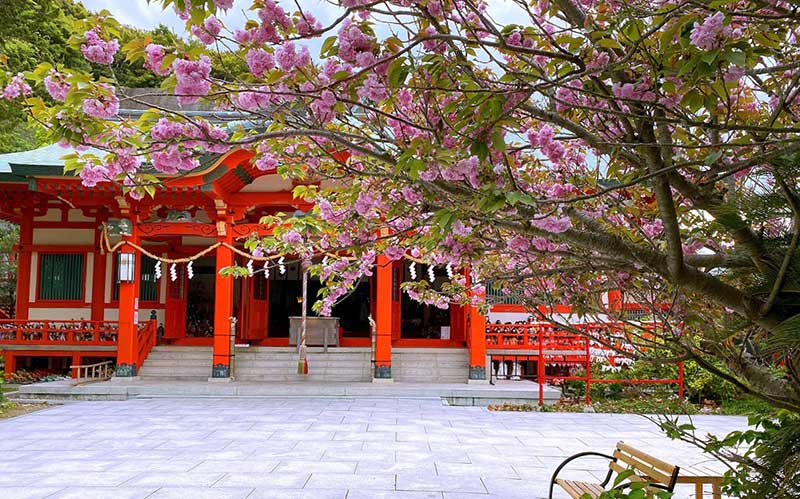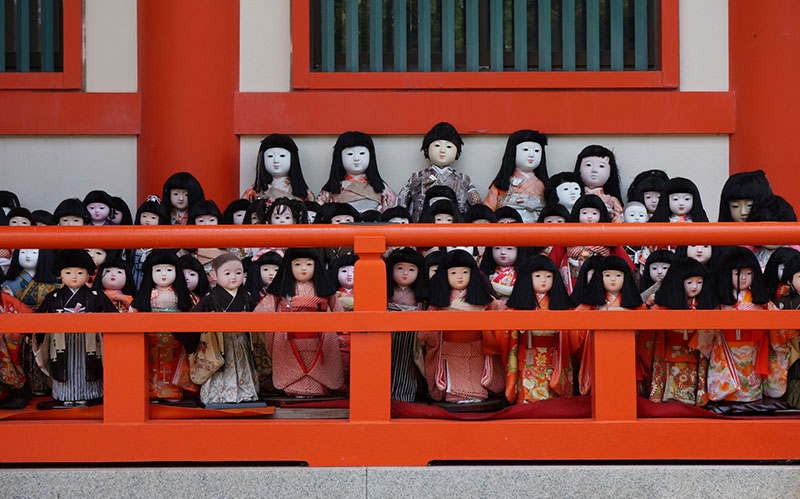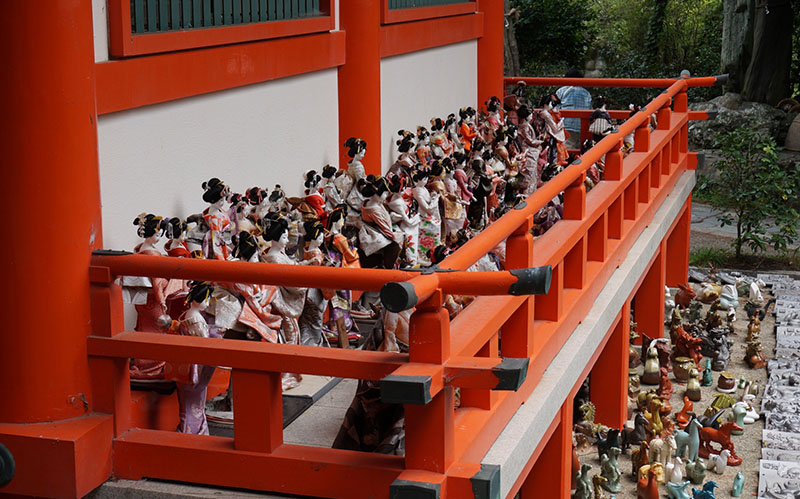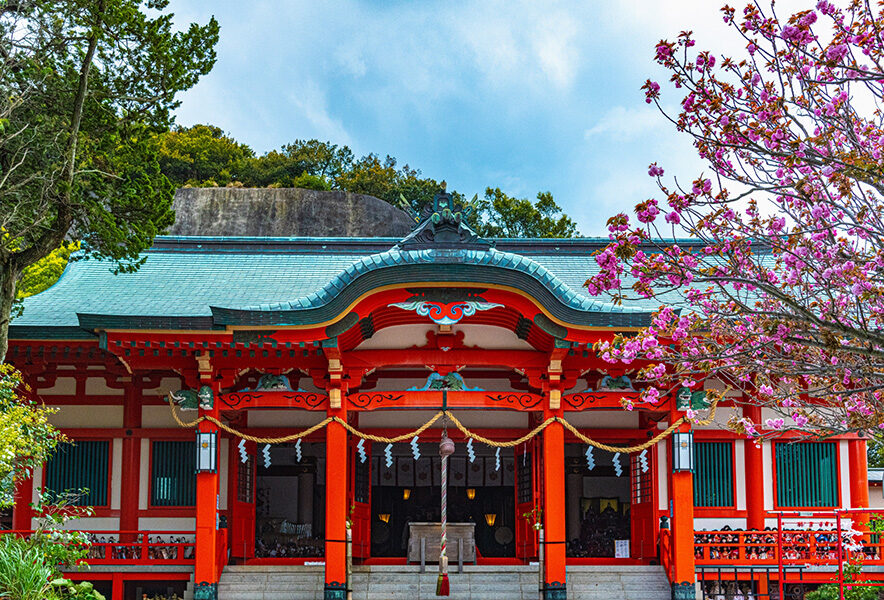The story of Awashima jinjya Shrine in Kada, famous for the “Hina Nagashi ritual
Awashima jinjya Shrine, located in Kada, Wakayama City, is the head shrine of all Awashimajinjya shrines in Japan.Empress Jingu (Princess Isochotokime no Mikoto) was caught in a storm on her way back from a campaign in Korea, and when she prayed to God in the boat, he told her to “throw the boat’s toma into the sea and let the current carry the boat forward.
They arrived at “Tomogashima,” where Sukunahikono-no-mikoto and Ohonamuji-no-mikoto were enshrined. The Empress made an offering of the treasures she had brought back in thanks for their help.
It is said that Emperor Nintoku, a grandson of Empress Jingu, heard the story when he went to Tomogashima to hunt and built a shrine on Kata on the opposite shore because he thought he would be inconvenienced on the island.
One of the deities, Sunahikono-no-mikoto, is the “god of medicine” and was believed to be especially beneficial to women for recovery from illness, safe delivery, and childbirth.
It is said that if you wear an amulet from Awashima Shrine, you will “never get sick in the lower half of your body,” and there is a tradition of praying for the healing of illness by delivering “underwear For this reason, many women now come to the shrine grounds.
For this reason, many women now come from all over Japan to dedicate their underwear.
Awashima Shrine is also famous for the “Hina-nagashi ritual,” in which the hina dolls are placed on a small white wooden boat and floated into the sea at Kata on March 3 every year while many worshippers watch.
The sight of the small boat being floated into the sea may bring a sense of sadness or gratitude to the hina dolls for watching over them as they grew up.

Highlights of Awashima jinjya Shrine
Gosyuin red ink stamp
At Awashima jinjya Shrine, all stamps, from the shrine name to the date, are stamped with a red ink seal. Red seals can be obtained at the awarding office. Simply open your “red seal book” to the page you want stamped and hand it to the staff. Awashima Shrine also sells red ink books.
Birthplace of the Hina Matsuri (Doll Festival)
Some people believe that Hinamatsuri became Hinamatsuri when the festival was dedicated to the deity Sunahiko no Mikoto.
It is said that March 3rd was the day when the deity was welcomed from Tomogashima to Kata. In addition, Harutomi, the 10th lord of the domain, built a hina storehouse to store the implements used by the princess and queen, which have been kept there for generations. They are now stored in the Treasure House.
As it is a “god for women,” there are various kinds of cute amulets and heart-shaped ema (votive picture tablet), as well as limited-edition goods such as tenugui (hand towels) and bath salts.
Memorial Service for Dolls
The many dolls lined up in the hall of worship are mysterious and have a fantastic atmosphere. It is said that things with eyes have souls, and many people hesitate to throw away dolls, stuffed animals, etc., which have various feelings, as garbage. If you bring them to this shrine, they will be offered for memorial services.


Associated with Kinokuniya Bunzaemon, a wealthy merchant in the Edo period
Kinokuniya Bunzaemon, who made a huge fortune in his lifetime, is famous for the story of how he carried oranges from Kishu (Wakayama Prefecture) to Edo (present-day Tokyo) despite meeting storms many times. Before moving to Edo, he dedicated an oinari-san to the goddess of fortune, as he was born in Yuasa, now Wakayama Prefecture. The “Kibun no Hashibashira” is a sailing post of a mandarin orange boat, and it is said that if you pass through the hole in the post while chanting your wish, your wish will come true.
Why not explore an island reminiscent of “Laputa: Castle in the Sky”?
Tomogashima is the collective name for Okinoshima Island and other islands in the Kitan Strait. Okinoshima has a beautiful contrast between the cobalt blue sea and a white Western-style lighthouse.
The ruins of a World War II gun emplacement and an observatory can be seen on the island, and as many as 400 species of marsh plants grow in clusters in the center of the island. The island has a long history, with historical sites and places of practice related to Shugendo, the ascetic practice that began with Enno Gyoja still in existence. On this island where nature and man-made structures coexist, you may feel the beauty of nature and the indescribable wretchedness of buildings.
On the approach to “Awashima Shrine,” there are several stores where visitors can enjoy not only souvenirs but also fresh and delicious meals. You can enjoy tiohigari (ebb and flow fishing) in spring and early summer, and swimming and playing in the sea and fishing in summer. There are also hot springs where you can relax and forget about everyday life.
Access to Awashima jinjya Shrine
118 Kada, Wakayama City, Wakayama Prefecture, 640-0103, Japan
Parking around Awashima jinjya Shrine
Awashima jinjya Shrine Official Website
Official site:http://www.kada.jp/awashima/
